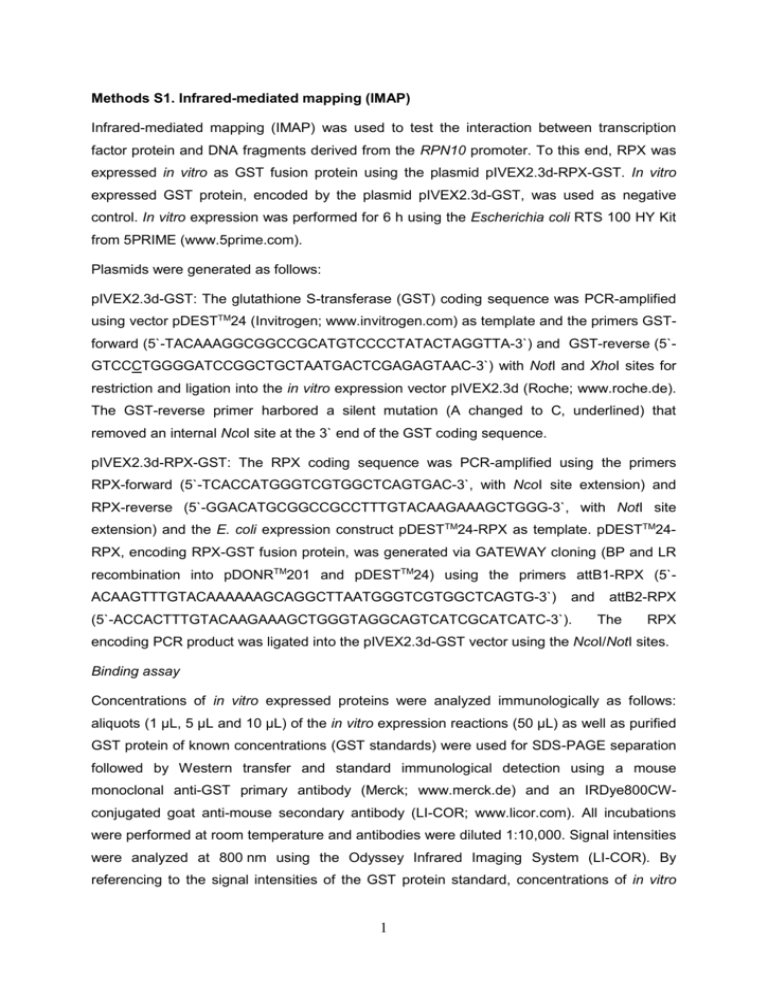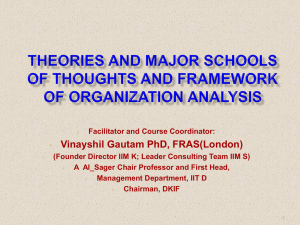tpj12097-sup-0011-MethodsS1
advertisement

Methods S1. Infrared-mediated mapping (IMAP) Infrared-mediated mapping (IMAP) was used to test the interaction between transcription factor protein and DNA fragments derived from the RPN10 promoter. To this end, RPX was expressed in vitro as GST fusion protein using the plasmid pIVEX2.3d-RPX-GST. In vitro expressed GST protein, encoded by the plasmid pIVEX2.3d-GST, was used as negative control. In vitro expression was performed for 6 h using the Escherichia coli RTS 100 HY Kit from 5PRIME (www.5prime.com). Plasmids were generated as follows: pIVEX2.3d-GST: The glutathione S-transferase (GST) coding sequence was PCR-amplified using vector pDESTTM24 (Invitrogen; www.invitrogen.com) as template and the primers GSTforward (5`-TACAAAGGCGGCCGCATGTCCCCTATACTAGGTTA-3`) and GST-reverse (5`GTCCCTGGGGATCCGGCTGCTAATGACTCGAGAGTAAC-3`) with NotI and XhoI sites for restriction and ligation into the in vitro expression vector pIVEX2.3d (Roche; www.roche.de). The GST-reverse primer harbored a silent mutation (A changed to C, underlined) that removed an internal NcoI site at the 3` end of the GST coding sequence. pIVEX2.3d-RPX-GST: The RPX coding sequence was PCR-amplified using the primers RPX-forward (5`-TCACCATGGGTCGTGGCTCAGTGAC-3`, with NcoI site extension) and RPX-reverse (5`-GGACATGCGGCCGCCTTTGTACAAGAAAGCTGGG-3`, with NotI site extension) and the E. coli expression construct pDESTTM24-RPX as template. pDESTTM24RPX, encoding RPX-GST fusion protein, was generated via GATEWAY cloning (BP and LR recombination into pDONRTM201 and pDESTTM24) using the primers attB1-RPX (5`ACAAGTTTGTACAAAAAAGCAGGCTTAATGGGTCGTGGCTCAGTG-3`) and (5`-ACCACTTTGTACAAGAAAGCTGGGTAGGCAGTCATCGCATCATC-3`). attB2-RPX The RPX encoding PCR product was ligated into the pIVEX2.3d-GST vector using the NcoI/NotI sites. Binding assay Concentrations of in vitro expressed proteins were analyzed immunologically as follows: aliquots (1 µL, 5 µL and 10 µL) of the in vitro expression reactions (50 µL) as well as purified GST protein of known concentrations (GST standards) were used for SDS-PAGE separation followed by Western transfer and standard immunological detection using a mouse monoclonal anti-GST primary antibody (Merck; www.merck.de) and an IRDye800CWconjugated goat anti-mouse secondary antibody (LI-COR; www.licor.com). All incubations were performed at room temperature and antibodies were diluted 1:10,000. Signal intensities were analyzed at 800 nm using the Odyssey Infrared Imaging System (LI-COR). By referencing to the signal intensities of the GST protein standard, concentrations of in vitro 1 expressed RPX-GST fusion protein and GST protein were determined, using the LI-COR Odyssey 2.1 software (LI-COR). After quantification, 500 ng of in vitro expressed RPX-GST fusion protein (experiment) or GST (negative control) were incubated with a 50%-slurry of magnetic glutathione beads (Promega; www.promega.com) according to manufacturer´s instructions. For optimal binding, incubation was done at 4°C for 24 h. After washing three times with 1 mL standard PBS buffer, the beads were resuspended in 50 µL PBS buffer supplemented with 200 ng of IRDye800CW-labeled DNA followed by incubation for 1 h at 4 °C on a rolling shaker. For competition reactions a mixture of non-labeled and labeled DNA was used (200 ng nonlabeled DNA mixed with 200 ng IRDye800CW-labeled DNA). DNA probes P1, P2 and P3 were generated as described in the manuscript. After incubation and washing five times with 1 mL PBS, proteins with bound DNA were eluted from beads with 30 µL standard protein loading buffer lacking Bromphenol Blue dye to avoid signal interference upon scanning at 800 nm. The eluted samples were transferred to 96-well microtiter plates with clear flat bottom (Carl Roth; www.carlroth.com). The signal intensities were scanned and analyzed at 800 nm using the Odyssey Infrared Imaging System and the Odyssey 2.1 software from LiCOR. RPX-GST signals were normalized to the GST signal and plotted. 2







